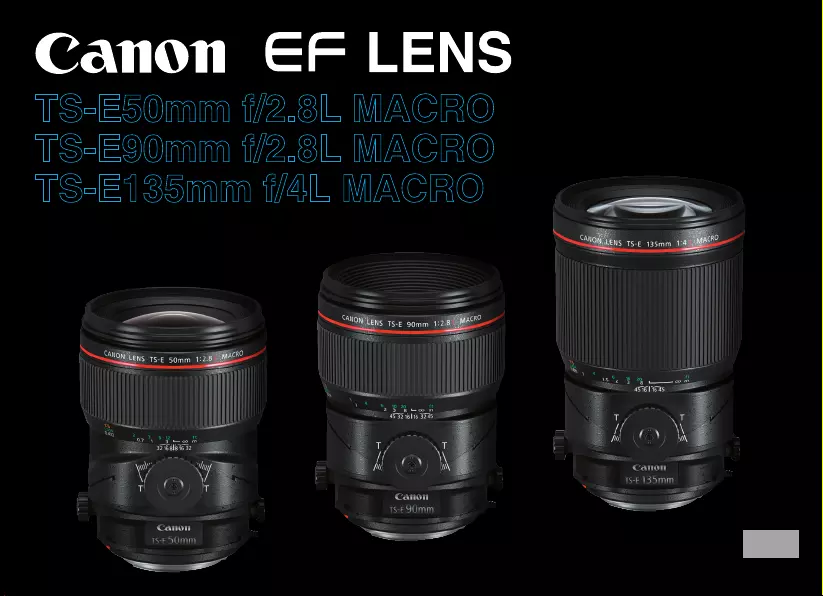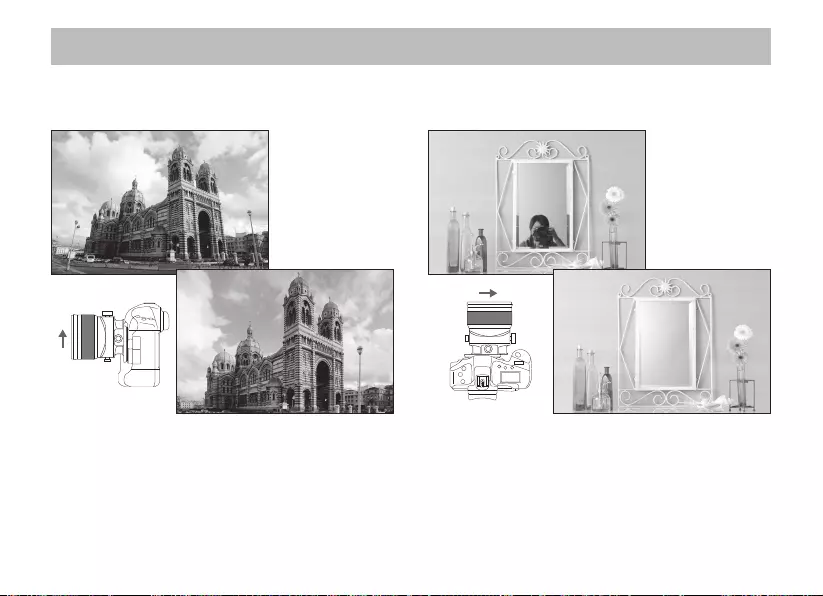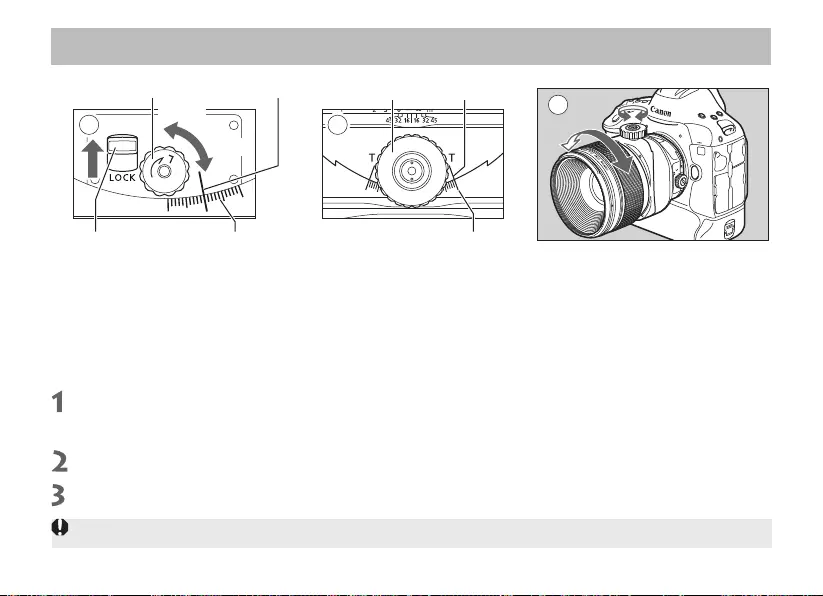Canon 2275C005 User Manual
Displayed below is the user manual for 2275C005 by Canon which is a product in the Camera Lenses category. This manual has pages.
Related Manuals

TS-E50mm f/2.8L MACRO
TS-E90mm f/2.8L MACRO
TS-E135mm f/4L MACRO
Instructions
ENG

ENG-1
Thank you for purchasing a Canon product.
The Canon TS-E50mm f/2.8L MACRO, Canon TS-E90mm f/2.8L MACRO, and Canon TS-E135mm
f/4L MACRO are tilt-shift lenses* designed for EOS cameras that allow macro shooting up to 0.5
times magnification.
Camera Firmware
Please use the latest version of firmware with the camera in use. For details on whether the
firmware is the latest version or not, and for details on updating the firmware, please check the
Canon website.
Conventions used in this instruction
Warning to prevent lens or camera malfunction or damage.
Supplementary notes on using the lens and taking pictures.
* Depending on the camera model, the orientation or movement required for operation differs somewhat.
For nomenclature and tilt operation, see the corresponding page for each model.
TS-E50mm f/2.8L MACRO
Nomenclature: p.5, p.6
Using tilt: p.15, p.16
TS-E90mm f/2.8L MACRO, TS-E135mm f/4L MACRO
Nomenclature: p.7, p.8
Using tilt: p.17, p.18

ENG-2
Safety Precautions
Precautions to ensure that the camera is used safely. Read these precautions thoroughly. Make sure all details are
observed in order to prevent risks and injury to the user and other people.
Caution Details pertaining to risks that may result in injury.
Do not leave the camera in locations subject to high or low temperatures. This may result in the camera becoming
excessively hot or cold, which may cause burns or other injuries when touched.
Do not insert your fingers inside the camera. Failure to observe this may result in injury.
Before mounting or detaching the lens, or turning the lens for rotation or TS rotation, always lock the lens in a
non-tilted and non-shifted position. Not doing so may cause injury.
When tilting or shifting the lens, avoid touching protrusions on the tilt mechanism and shift mechanism. Not
doing so may cause injury.
Caution Details pertaining to risks that may result in damage to property.
Do not leave the lens in excessive heat such as in a car in direct sunlight. High temperatures can cause the lens to
malfunction.
Do not turn knobs forcefully. This may cause malfunction.
When mounting or detaching the lens or turning the lens for rotation, always lock the lens in a non-tilted and non-shifted
position. Not doing so may cause malfunction.
Warning Details pertaining to risks that may result in death or serious injury.
Do not look at the sun or a bright light source through the lens or single-lens reflex camera. Doing so could result
in loss of vision. Looking at the sun directly through the lens is especially hazardous.
Whether it is attached to the camera or not, do not leave the lens under the sun without the lens cap attached.
This is to prevent the lens from concentrating the sun’s rays, which could cause a fire.

ENG-3
This device complies with Part 15 of the FCC Rules.
Operation is subject to the following two conditions: (1) This
device may not cause harmful interference, and (2) this
device must accept any interference received, including
interference that may cause undesired operation.
Do not make any changes or modifications to the equipment
unless otherwise specified in the instructions. If such changes
or modifications should be made, you could be required to
stop operation of the equipment.
This equipment has been tested and found to comply with
the limits for a class B digital device, pursuant to part 15
of the FCC Rules. These limits are designed to provide
reasonable protection against harmful interference in a
residential installation. This equipment generates, uses and
can radiate radio frequency energy and, if not installed and
used in accordance with the instructions, may cause harmful
interference to radio communications.
However, there is no guarantee that interference will not
occur in a particular installation. If this equipment does cause
harmful interference to radio or television reception, which
can be determined by turning the equipment off and on, the
user is encouraged to try to correct the interference by one or
more of the following measures:
• Reorient or relocate the receiving antenna.
• Increase the separation between the equipment and
receiver.
• Connect the equipment into an outlet on a circuit different
from that to which the receiver is connected.
• Consult the dealer or an experienced radio/TV technician
for help.
CAN ICES-3(B)/NMB-3(B)

ENG-4
General Precautions
Handling Precautions
If the lens is taken from a cold environment into a warm one, condensation may develop on the lens surface and
internal parts. To prevent condensation in this case, first put the lens into an airtight plastic bag before taking
it from a cold to warm environment. Then take out the lens after it has warmed gradually. Do the same when
taking the lens from a warm environment into a cold one.
Please also read any lens related handling precautions listed in your camera’s instruction manual.
Shooting Precautions
To ensure that you use the lens’ functions effectively, it is recommended that you shoot in the following
conditions.
• Use an EOS camera with about 100% viewnder visibility
• Use Live View (with onscreen grid)
• Use an external monitor
• Use a tripod
• Use a matte with grid focusing screen
• Use a stand-alone exposure meter
Since only a hood is not very effective in cutting off the harmful rays entering the lens, also using a piece of
cardboard is recommended.
If using Digital Photo Professional to perform lens correction (lens aberration correction, Digital Lens
Optimizer, etc.)*, shooting with rotation or TS rotation locked or at a click position is recommended.
* Supported cameras: EOS 6D Mark II (As of August 2017)

ENG-5
Nomenclature (TS-E50mm f/2.8L MACRO)
For detailed information, reference page numbers are provided in parentheses (→ **).
Distance index
Distance scale (→ 14, 28)
Depth-of-Field scale (→ 28)
Tilt knob (→ 15)
Shift knob (→ 19, 30)
Shift scale (→ 19)
Shift index (→ 19)
Contacts
Lens mount index (→ 14)
Tilt index (→ 15)
Tilt scale (→ 15)

ENG-6
Nomenclature (TS-E50mm f/2.8L MACRO)
For detailed information, reference page numbers are provided in parentheses (→ **).
Rotation lock release
button (→ 21)
TS rotation lock release
button (→ 23)
Tilt index (→ 15)
Tilt lock knob (→ 15)
Tilt lock button (→ 15)
Shift index (→ 19)
Shift scale (→ 19)
Shift lock knob (→ 19)
Filter mounting thread (→ 31)
Lens
Hood mount
Focusing ring (→ 14)
Tilt scale (→ 15)
Illustration shows lens viewed from below.

ENG-7
Nomenclature (TS-E90mm f/2.8L MACRO, TS-E135mm f/4L MACRO)
For detailed information, reference page numbers are provided in parentheses (→ **).
Distance index
Distance scale (→ 14, 28)
Depth-of-Field scale (→ 28)
Tilt knob (→ 17)
Shift knob (→ 19, 30)
Shift scale (→ 19)
Shift index (→ 19)
Contacts
Lens mount index (→ 14)
Tilt index (→ 17) Tilt scale (→ 17)
The illustration shows TS-E90mm f/2.8L MACRO, with nomenclature being the same for TS-E135mm f/4L MACRO.

ENG-8
Nomenclature (TS-E90mm f/2.8L MACRO, TS-E135mm f/4L MACRO)
For detailed information, reference page numbers are provided in parentheses (→ **).
Rotation lock release
button (→ 21)
TS rotation lock release
button (→ 23)
Tilt index (→ 17)
Tilt lock knob (→ 17)
Tilt lock button (→ 17)
Shift index (→ 19)
Shift scale (→ 19)
Shift lock knob (→ 19)
Filter mounting thread (→ 31)
Lens
Hood mount
Focusing ring (→ 14)
Tilt scale (→ 17)
Illustration shows lens viewed from below.
The illustration shows TS-E90mm f/2.8L MACRO, with nomenclature being the same for TS-E135mm f/4L MACRO.

ENG-9
TS-E MACRO Lens Features
Canon TS-E50mm f/2.8L MACRO, Canon TS-E90mm f/2.8L MACRO, and Canon TS-E135mm f/4L
MACRO have the following features.
Range of tilt is ±8.5° for TS-E50mm f/2.8L MACRO, and ±10° for TS-E90mm f/2.8L MACRO and
TS-E135mm f/4L MACRO.
Range of shift is ±12 mm.
Macro shooting at up to 0.5 times magnification when tilted or shifted is possible.
Rotation allows the direction of the entire lens to be changed.
TS rotation allows the tilt operation angle to be changed in regard to shift.
These features can be combined to allow a diverse range of expressive possibilities.
Illustration shows TS-E50mm f/2.8L MACRO.
Focus mechanism
TS rotation mechanism
Shift mechanism
Rotation mechanism
Tilt mechanism

ENG-10
TS-E MACRO Lens Features
Before mounting or detaching the lens, or turning the lens for rotation or TS rotation, always lock the lens in
a non-tilted and non-shifted position.
For how to lock the lens in a non-tilted and non-shifted position, see p.16, p.18, and p.20.
If using Digital Photo Professional to perform lens correction (lens aberration correction, Digital Lens
Optimizer, etc.)*, correction may not be performed adequately depending on the amount of tilt or shift, and
on the rotation or TS rotation setting.
*Supported cameras: EOS 6D Mark II (As of August 2017)

ENG-11
The Principle of Tilt and Shift
光軸
By tilting the lens, the lens’ optical axis
is tilted with regard to the imaging plane,
allowing the focusing plane to be tilted.
By shifting the lens, the lens’ optical axis
is moved in parallel with regard to the
image plane, allowing the focusing plane
to be moved in parallel.
Focusing plane
(after shifting)
Optical
axis
Optical
axis Shift
Tilt
Imaging planeImaging plane Imaging plane
Focusing plane
(after tilting) Focusing plane

ENG-12
Tilt Effect
Shooting a field of flowers
Tilting as shown has the effect of broadening the
depth of field. This allows the entire field, from
immediately in front to far in the background, to be
in focus.
Example 1 Example 2
Tilting as shown has the effect of narrowing the depth
of field. Only flowers immediately in front are in focus,
with the rest of the subject being blurred.

ENG-13
Shift Effect
Shooting architecture Shooting a mirror
If you photograph a subject such as a building with
a normal lens, the top of the building tapers away.
But by placing the camera parallel to the building
and shifting the lens, you can correct this tapering
effect.
When you are shooting a reflective subject, you
can move the camera to a position where the
camera does not appear in the shot and then use
shift to take the picture. This lets you keep the
camera out of the shot without having to change
the shot composition.

ENG-14
1. Mounting and Detaching the Lens
See your camera’s instructions for details on
mounting and detaching the lens.
Before mounting or detaching the lens, always
lock the lens in a non-tilted and non-shifted
position.
After detaching the lens, place the lens with
the rear end up to prevent the lens surface and
contacts from getting scratched.
Contacts that are scratched, soiled, or have
fingerprints on them may result in faulty
connections or corrosion, which may lead to
malfunctions. If the contacts get soiled, clean
them with a soft cloth.
Attach the lens cap and dust cap when
disconnecting the lens. When attaching the dust
cap, align the lens mount index with the index
of the dust cap and turn in a clockwise direction
as shown in the illustration. Follow the reverse
procedure to detach it.
2. Focusing
Illustration shows TS-E50mm f/2.8L MACRO.
Focus the lens by manually turning the focusing
ring. (Shots cannot be taken using autofocus.)
After tilting or shifting the lens, or turning the lens
for rotation or TS rotation, readjust the focus.
The distance scale is only valid when the lens is
not tilted or shifted.
For cameras which allow Live View shooting,
focusing using the LCD monitor’s magnified
image is recommended.

ENG-15
3. Using Tilt (TS-E50mm f/2.8L MACRO)
2
1
To tilt the lens, slide the tilt lock button away from LOCK, and then turn the tilt lock knob
counterclockwise to loosen. (Fig. 1)
Tilting the lens for shooting
Turn the tilt knob to adjust the amount of tilt. The amount of tilt can be adjusted in a range of
±8.5° with the thick line on the tilt scale as a reference. (Fig. 2) (A tilt scale is also located near
the tilt lock knob.)
Focus the shot by turning the focusing ring. (Fig. 3)
Turn the tilt lock knob clockwise and lock it before taking the shot. (Fig. 1)
Do not turn the tilt knob forcefully. This may cause malfunction.
Tilt lock knob
Tilt lock button Tilt index
Tilt scale
Tilt index
Tilt scaleTilt knob
3
Lock
Loosen
Illustration shows TS-E50mm f/2.8L MACRO.

ENG-16
Locking the Lens in a Non-Tilted Position
Turn the tilt knob so that the thick line on the tilt scale is aligned with the tilt index (at a click
position). (Fig. 1)
Turn the tilt lock knob clockwise to lock. Slide the tilt lock button toward LOCK to lock tilt. (Fig. 2)
When tilt is locked with the tilt lock button, do not turn the tilt knob. This may cause malfunction.
Using Tilt (TS-E50mm f/2.8L MACRO)
12
Tilt lock knob
Tilt lock button Tilt index
Thick line on tilt scale
Tilt index
Thick line on tilt scaleTilt knob
Illustration shows TS-E50mm f/2.8L MACRO.
Lock

ENG-17
Using Tilt (TS-E90mm f/2.8L MACRO, TS-E135mm f/4L MACRO)
2
1
To tilt the lens, slide the tilt lock button away from LOCK, and then turn the tilt lock knob
counterclockwise to loosen. (Fig. 1)
Tilting the lens for shooting
Turn the tilt knob to adjust the amount of tilt. The amount of tilt can be adjusted in a range of ±10°
with the thick line on the tilt scale as a reference. (Fig. 2) (A tilt scale is also located near the tilt
lock knob.)
Focus the shot by turning the focusing ring. (Fig. 3)
Turn the tilt lock knob clockwise and lock it before taking the shot. (Fig. 1)
Do not turn the tilt knob forcefully. This may cause malfunction.
Tilt lock knob
Tilt lock button Tilt scale
Tilt index
Tilt scale
Tilt indexTilt knob
3
Illustration shows TS-E90mm f/2.8L MACRO.
Location of features on TS-E90mm f/2.8L MACRO and TS-E135mm f/4L MACRO differ
somewhat from TS-E50mm f/2.8L MACRO, but their function and operation is the same.
Lock
Loosen

ENG-18
Locking the Lens in a Non-Tilted Position
Turn the tilt knob so that the thick line on the tilt scale is aligned with the tilt index (at a click
position). (Fig. 1)
Turn the tilt lock knob clockwise to lock. Slide the tilt lock button toward LOCK to lock tilt. (Fig. 2)
When tilt is locked with the tilt lock button, do not turn the tilt knob. This may cause malfunction.
Using Tilt (TS-E90mm f/2.8L MACRO, TS-E135mm f/4L MACRO)
12
Tilt lock knob
Tilt lock button
Tilt index
Thick line on tilt scale Thick line on tilt scale
Tilt indexTilt knob
Lock
Illustration shows TS-E90mm f/2.8L MACRO.

ENG-19
2
3
1
To shift the lens, turn the shift lock knob counterclockwise to loosen. (Fig. 1)
Shifting the lens for shooting
Turn the shift knob to adjust the amount of shift. The amount of shift can be adjusted in a range of
±12 mm with the thick line on the shift scale as a reference. (Fig. 2) (A shift scale is also located
near the shift lock knob.)
Focus the shot by turning the focusing ring. (Fig. 3)
Turn the shift lock knob clockwise and lock it before taking the shot. (Fig. 1)
Do not turn the shift knob forcefully. This may cause malfunction.
4. Using Shift
Shift lock knobShift index
Shift scale Shift index
Shift scale
Shift knob
Lock
Loosen
Illustration shows TS-E50mm f/2.8L MACRO.

ENG-20
Using Shift
Locking the Lens in a Non-Shifted Position
Turn the shift knob so that the thick line on the shift scale is aligned with the shift index (at a click
position). (Fig. 1)
Turn the shift lock knob clockwise to lock. (Fig. 2)
For EOS cameras with built-in flash, the lens may contact the camera while you operate the shift function.
With large amounts of shift, the amounts of peripheral light at the top and bottom or left and right sides of
the screen may differ, so shooting with a small aperture is recommended.
The shift operation will be easier if the supplied cap is mounted on the shift knob (p.30)
12
Shift lock knobShift index
Shift scaleShift index
Thick line on shift scale
Shift knob
Lock
Illustration shows TS-E50mm f/2.8L MACRO.

ENG-21
5. Using Rotation
By using rotation, the direction of the entire lens can be switched.
With the lens mounted on the camera, turn the entire lens while
pushing the rotation lock release button toward the mount.
Rotation lock release button
The rotation mechanism can be
turned through ±90°. The lens clicks
every 30°, and locks in place in the
0° and ±90° positions.
Shift directions when rotation
is at 0°.
Shift directions when rotation
is at 90°.
Illustration shows TS-E50mm f/2.8L MACRO.

ENG-22
Before turning the lens for rotation, always lock the lens in a non-tilted and non-shifted position.
Note that your fingers may contact the shift lock knob when turning the lens for rotation.
For EOS cameras with built-in flash, the lens may contact the camera while you operate the rotation
function.
In order to prevent shifts in position while shooting, shooting with rotation locked or at a click position is
recommended.
If using Digital Photo Professional to perform lens correction (lens aberration correction, Digital Lens
Optimizer, etc.)*, shooting with rotation locked or at a click position is recommended so as to reduce the
amount of correction error.
*Supported cameras: EOS 6D Mark II (As of August 2017)
Using Rotation

ENG-23
6. Using TS Rotation
By using TS rotation, the relationship of the tilt and shift operation
directions can be switched from right angle to parallel.
With the lens mounted on the camera, turn the tilt mechanism while
pressing the TS rotation lock release button toward the mount.
TS rotation lock release button
The lens clicks at the 45° position,
and locks in place in either the right
angle or parallel position.
Tilt and shift directions in
right angle TS rotation
Tilt and shift directions in
parallel TS rotation
Illustration shows TS-E50mm f/2.8L MACRO.

ENG-24
Using TS Rotation
In order to prevent shifts in position while shooting, shooting with TS rotation locked or at a click position is
recommended.
If using Digital Photo Professional to perform lens correction (lens aberration correction, Digital Lens
Optimizer, etc.)*, shooting with TS rotation locked or at a click position is recommended so as to reduce the
amount of correction error.
*Supported cameras: EOS 6D Mark II (As of August 2017)
Before turning the lens for TS rotation, always lock the lens in a non-tilted and non-shifted position.
When tilt and shift are used together in right-angled operation directions, or only either of tilt or shift is used,
vignetting by this lens will not occur.
When tilt and shift are used together in any operation directions other than right-angled, vignetting may
occur in the range indicated in gray as shown in the figure below. For example, when the tilt and shift
operation directions are parallel, and tilt and shift are each at their maximum setting. When using TS rotation
in conditions where vignetting may occur, it is recommended to shoot while checking results after shooting
an image.
TS-E50mm f/2.8L MACRO
1
1
2
3
4
5
6
7
8
8.5
2345678910 11 12
Amount of tilt (degrees)
Amount of shift (mm)
TS-E90mm f/2.8L MACRO
1
1
2
3
4
5
6
7
8
9
10
2345678910 11 12
Amount of tilt (degrees)
Amount of shift (mm)
TS-E135mm f/4L MACRO
1
1
2
3
4
5
6
7
8
9
10
2345678910 11 12
Amount of tilt (degrees)
Amount of shift (mm)

ENG-25
7. TS-E MACRO Lens Exposure Setting
Since the optical axis shifts when the lens is tilted or shifted, the exposure value may deviate largely
with automatic exposure during viewfinder shooting. Either of the following methods is recommended
for obtaining an appropriate exposure setting.
Exposure setting by Live View shooting
Shoot using a Live View shooting exposure value.
Regardless of tilt or shift, you can shoot with automatic exposure, including for macro shots.
Exposure setting by stand-alone exposure meter
Shoot using manual exposure using the exposure value obtained from a stand-alone exposure meter
as a guide.
Macro shooting requires an exposure compensation that is according to the magnification. Shoot
using the exposure value obtained from the stand-alone exposure meter with an exposure factor in
the table on the next page added.
With either exposure setting method, you may not be able to obtain an appropriate exposure depending
on shooting conditions. It is recommended that you try shooting after changing the exposure as much as
possible, or while checking results after shooting an image.

ENG-26
TS-E50mm f/2.8L MACRO
Magnification 1:5 1:3 1:2
Upper values: 1/3 stops.
Lower values: 1/2 stops.
Effective f/No. 3.3 3.4 3.8
Exposure Factor
(stops)
1/3 2/3 2/3
1/2 1/2 1
TS-E90mm f/2.8L MACRO
Magnification 1:5 1:3 1:2
Upper values: 1/3 stops.
Lower values: 1/2 stops.
Effective f/No. 3.4 3.8 4.3
Exposure Factor
(stops)
1/3 2/3 1
1/2 1 1
TS-E135mm f/4L MACRO
Magnification 1:5 1:3 1:2
Upper values: 1/3 stops.
Lower values: 1/2 stops.
Effective f/No. 4.8 5.2 5.8
Exposure Factor
(stops)
1/3 2/3 1
1/2 1/2 1
TS-E MACRO Lens Exposure Setting

ENG-27
Depending on the camera model* and settings, you may not obtain standard exposure or you may obtain
uneven exposure.
This phenomenon may improve by decreasing the shutter speed.
It is recommended that you try shooting while checking results after shooting an image.
* • The rmware in the below cameras already corrects this phenomenon.
EOS 6D Mark II
• Upgrading the rmware in the below cameras will correct this phenomenon.
EOS 5D Mark IV, EOS 5D Mark III, EOS 5DS, EOS 5DS R, EOS-1D X Mark II, EOS-1D X,
EOS 6D
For details on firmware, see the Canon website.
TS-E MACRO Lens Exposure Setting

ENG-28
8. Depth-of-Field Scale
9. Infinity Compensation Mark
For accurate manual focusing of subjects at
infinity, look through the viewfinder or look at
the magnified image on the LCD screen while
turning the focusing ring.
The depth-of-field scale is only valid when the
lens is not tilted or shifted.
The depth-of-field scale is an approximate
indicator.
To compensate for shifting of the infinity focus
point that results from changes in temperature,
there is a margin at the infinity (∞) position.
The infinity position at normal temperature is the
point at which the vertical line of the distance
scale L mark is aligned with the distance index.
The depth of field is the distance in front of and
behind the plane of focus on the subject that
appears sharp. The depth of field is indicated by
the area between the depth-of-field scale lines
below the distance scale.
The numbers on the scale are aperture settings.
Distance
scale
Depth-of-field
scale
Distance
index
Infinity
compensation mark
Distance
scale
Illustration shows TS-E50mm f/2.8L MACRO.

ENG-29
10. Hood
If the hood is not attached properly, vignetting (darkening of the perimeter of the picture) may occur.
Grasp and turn the base of the hood when attaching and detaching it. There are cases in which it may
become deformed if the hood is turned with it grasped near to the rim.
Since only a hood is not very effective in cutting off the harmful rays entering the lens, also using a piece of
cardboard is recommended.
The ES-84 or ET-88 hood cuts out unwanted light and protects the front of the lens from rain, snow,
and dust.
Attaching
To attach the hood, align the hood’s red
attachment position mark with the red dot on the
front of the lens, then turn the hood as shown by
the arrow until it clicks.
Attachment position mark
Red dot
Red dot
Stop position markAttachment position mark
Red dot Illustration shows TS-E50mm f/2.8L MACRO.
Removing
Keep your finger pressed down on the button
located on the side of the hood, and then turn
the hood in the direction of the arrow until the
attachment position mark on the hood is aligned
with the red dot on the front of the lens to
detach it. The hood can be reverse-mounted on
the lens for storage.
Button

ENG-30
11. Shift Knob Cap
Be sure to fix the cap in place using the supplied screw (length: 3 mm).
The removed screw (length: 2.2 mm) cannot be used to fix the cap in place. Store the removed screw, as it
will be required when not using the cap.
Use a precision screwdriver (Phillips).
Do not turn the shift knob forcefully. This may cause malfunction.
Shifting will be easier if the supplied shift knob cap is mounted (p.19).
However, note that for EOS cameras with a built-in flash, the cap may come in contact with the
camera when mounting/detaching the lens, shifting the lens, or turning the lens for rotation.
Mount the cap by squeezing it onto
the shift knob, and then fix it in
place using the supplied screw.
Remove the shift knob
screw.
Screw (length: 3 mm)
Shift knob cap

ENG-31
12. Filters (sold separately)
13. Close-up Lens (sold separately)
TS-E50mm f/2.8L MACRO
Attaching a 500D (77 mm) Close-up Lens
enables close-up photography.
It provides a magnification of 0.10x to 0.58x.
Close-Up Lens 250D does not have a compatible
size.
TS-E90mm f/2.8L MACRO
Attaching a 500D (77 mm) Close-up Lens
enables close-up photography.
It provides a magnification of 0.18x to 0.69x.
Close-Up Lens 250D does not have a compatible
size.
TS-E135mm f/4L MACRO
Close-Up Lenses 250D and 500D do not have
compatible sizes.
You can attach filters to the filter mounting thread
on the front of the lens.
Only one filter may be attached.
Use a Canon circular polarizing filter PL-C B.
TS-E50mm f/2.8L MACRO and TS-E90mm
f/2.8L MACRO: 77mm
TS-E135mm f/4L MACRO: 82mm
Detach the hood when adjusting the polarizing
filter.

ENG-32
14. Extension Tubes (sold separately)
You can attach extension tube EF12 II or EF25 II for magnified shots. The focusing distance and
magnification are shown below.
TS-E50mm f/2.8L MACRO
Focusing distance (mm)
(working distance) Magnification (×)
Near Far Near Far
EF12 II 242
(57)
371
(216) 0.74 0.23
EF25 II 224
(44)
256
(101) 1.00 0.48
TS-E90mm f/2.8L MACRO
Focusing distance (mm)
(working distance) Magnification (×)
Near Far Near Far
EF12 II 365
(162)
821
(648) 0.64 0.15
EF25 II 352
(134)
493
(305) 0.82 0.32

ENG-33
Extension Tubes (sold separately)
TS-E135mm f/4L MACRO
Focusing distance (mm)
(working distance) Magnification (×)
Near Far Near Far
EF12 II 459
(263)
1716
(1521) 0.62 0.09
EF25 II 443
(232)
943
(733) 0.77 0.20

ENG-34
15. TS-E Tripod Adapter (sold separately)
With some camera models, the tilt, shift and rotation functions cannot be used when the camera is
mounted directly on a tripod. When this happens, fit the optional TS-E tripod adapter into the tripod
mount socket on the camera before mounting the camera on the tripod.
Illustration shows TS-E50mm f/2.8L MACRO.

ENG-35
Specifications
TS-E50mm f/2.8L MACRO TS-E90mm f/2.8L MACRO TS-E135mm f/4L MACRO
Focal Length/Aperture 50mm f/2.8 90mm f/2.8 135mm f/4
Lens Construction 12 elements in 9 groups 11 elements in 9 groups 11 elements in 7 groups
Minimum Aperture f/32 f/45 f/45
Angle of View
(Normal)
Horizontal 40° 22°40’ 15°
Vertical 27° 15°10’ 10°
Diagonal 46° 27° 18°
Min. Focusing Distance
(working distance)
0.273 m/0.896 ft
(89 mm/3.50 in)
0.390 m/1.281 ft
(200 mm/7.87 in)
0.486 m/1.595 ft
(303 mm/11.93 in)
Max. Magnification 0.5 times
Field of View Approx. 72 × 48 mm/2.83 × 1.89 in
Tilt amount ±8.5° ±10°
Shift amount ±12 mm
Tilt scale display 1° increments
Shift scale display 1-mm increments
Rotation mechanism Locks at -90°, 0°, and +90° positions
Clicks each 30°
TS Rotation mechanism Locks at right angle and parallel positions
Clicks at 45°
Filter Diameter 77mm 82mm
Max. Diameter × Length
86.9 × 114.9 mm/3.42 × 4.52 in 86.9 × 116.5 mm/3.42 × 4.59 in 88.5 × 139.1 mm/3.48 × 5.48 in
Weight Approx. 945 g/33.3 oz Approx. 915 g/32.3 oz Approx. 1110 g/39.2 oz
Hood ES-84 ET-88
Lens Cap E-77II E-82II
Case LP1219 LP1424

ENG-36
The lens length is measured from the mount surface to the front end of the lens. Add 24.2 mm when including
the lens cap and dust cap.
The size and weight listed are for the lens only, except as indicated.
Extenders cannot be used with this lens.
Macro Ring Lite MR-14EX II and Macro Twin Lite MT-24EX cannot be used with this lens.
Aperture settings are specified on the camera.
All data listed is measured according to Canon standards.
Product specifications and appearance are subject to change without notice.
Specifications

CT1-D009-A 1707SZ © CANON INC. 2017